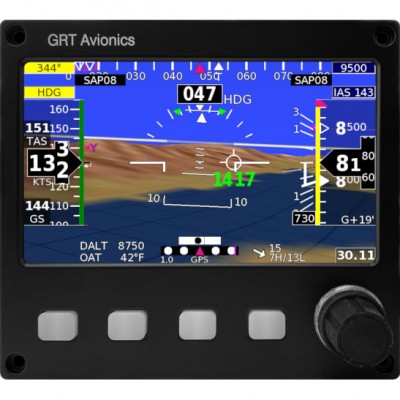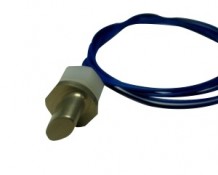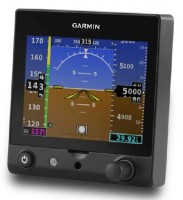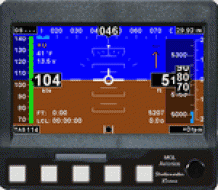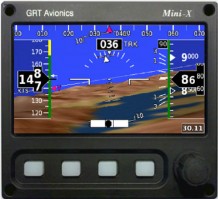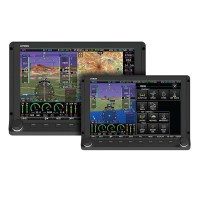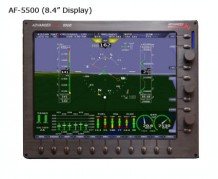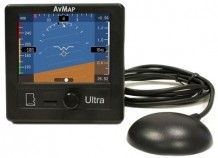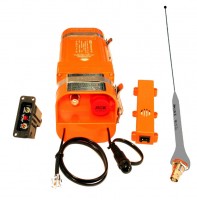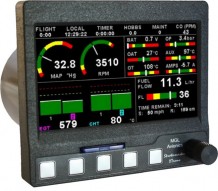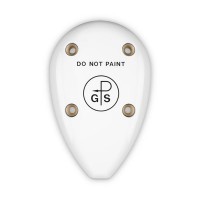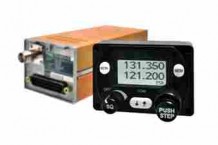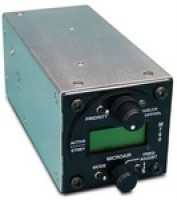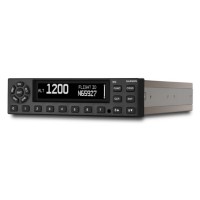1-877-795-2278 | info@aircraftspruce.ca
Aircraft Spruce Canada
Brantford, ON Canada
Corona, CA | Peachtree City, GA
Chicago, IL | Wasilla, AK
Aircraft Spruce Canada
Brantford, ON Canada
Corona, CA | Peachtree City, GA
Chicago, IL | Wasilla, AK
THE AVIATION SUPERSTORE FOR ALL YOUR AIRCRAFT & PILOT NEEDS | 877-795-2278
Grand Rapids Mini EFIS Generation II
$2699.00/Each
Part# 11-20349
MFR Model# MINI GEN 2
MFR Model# MINI GEN 2
Overview
|
As A Primary Flight Display
The Mini EFIS includes an electronic attitude source (AHRS) that is not dependent on GPS and/or air data. IFR certifiable altitude, vertical speed, and airspeed are boldly shown with tapes and smoothly rotating drum-style digital displays that instinctively convey value and trend. Internal or external GPS navigation and steering data is provided on the PFD, and highway-in-the sky guidance to any runway in the database. The addition of the external magnetometer adds heading and winds. The primary flight display screen terrain showing relative height. In the upper left the autopilot/flight director mode is shown as synthetic approach to runway 35. The flight director is commanding a slight pitch down in the center of the screen. The airspeed and altimeter drums move smoothly and the high-contrast digits make them highly readable. Extending up from the runway is the way-point balloon. Optional Moving Map The moving map has the features you would only expect to find in a full size EFIS. It includes such features as terrain relief, relative terrain height color coding, nearest functions, airport details including frequencies and runways, and much more. When connected to an external GPS, its flight plan and steering information can be displayed on and drive the map. Smooth Rotation Moving Map Hand-held or panel mount GPS navigators update their display once per second. Some EFIS based moving maps do same. The result is a jerky and delayed map. The Mini combines AHRS and GPS data to update its map at up to 15 times per second, resulting in a smoothly rotating map. Rolling out of a turn precisely on track becomes easy and the extended runway centerlines eliminate the guess work, making navigation easier and more precise. HSI With a full featured moving map, the Mini extends its role by coupling to other navigation sources, such as navigation radios. The Mini includes and OBS (radial) selector for VOR or LOC/ILS navigation. Lateral and vertical deviations are also displayed on the primary flight display. Angle-of-Attack (AOA) Sensing/Stall Warning Angle-of-attack sensing is available as an upgrade on the Mini. Sensing is via a two-port 45 degree pitot tube, such as those commonly available from a variety of manufacturers, or using a probe fashioned by the builder. This method has no moving parts, and allows the use of heated pitot tubes that preserve the stall warning function even in the presence of icing. The GRT Avionics AOA function drives on-screen AOA symbology that shows too fast/too slow/optimal approach speeds, as well as stall warning. In addition, an audio output is provided on the Mini. This audio provides an approaching stall warning annunciation (a pulsating tone that varies with proximity to the stall warning angle) and a solid tone indicating stall is imminent. Engine Monitoring Practically identical to the engine monitoring provided by our larger EFIS systems, the Mini engine monitoring provides 6 engine pages, percent power calculation, and GRT exclusives (such as the EGT and CHT time histories and engine efficiency via the specific fuel consumption display). Probably the most popular of the engine monitoring screens is the EGT time history page. In addition to two user-programmable dials, fuel management, and basic engine data. This screen includes a 2-minute history of all EGTs. This GRT exclusive allows you to effortlessly distinguish between engine problems affecting one cylinder or the engine itself. It also makes it easy to see small changes in engine operation that might not otherwise be noticeable. Even better, this display provides reassurance that your engine is running normally, especially when flying over water or at night. If the EGTs are steady, so is the engine. ADS-B Real-time traffic and weather is now a practical reality, and it is fully supported by the Mini. Unlike a tablet, the Mini’s screen is always readable, remains fully controllable in turbulence, and doesn’t suffer from overheating problems. NexRad Weather Radar
Install an optional Bluetooth dongle and connect with your Android phone or tablet using our GRT REMOTE App for Android*. Control tuning of your connected radios, create & edit active flight plans, and view the flight instruments all on your Android tablet or phone–perfect for the backseat co-pilot. The radio tuning portion of the app offers so much information, you may not want to tune them without it! Integrates With Other GRT Equipment The Mini adds automatic cross-checking of its attitude with any GRT EFIS screen. The GRT EFIS flight plan is displayed and may be edited on the Mini Baroset and dimming is shared. In short, it adds another screen to your GRT equipped panel with complete integration via the inter-display unit link. Heads-Up Display Capable A heads up display can now be part your your GRT Avionics equipped airplane for as little as $300. Our pursuit of heads up display technology has led to support for the Hudly automotive after-market heads up display. Graphics optimizations in the GRT remote app, combined with the impressive readability and value of the Hudly have resulted in the first practical heads up display for experimental and general aviation (certified) airplanes.
|
Compatibility
GRT Systems are Specifically Designed to Play Nice with Other Manufacturers’ EquipmentEvery builder has his or her own taste when it comes to devices such as weather & traffic information, radios, transponders, and GPS units. We strive to give builders a choice when it comes to third-party equipment. This page is an overview of popular choices of our customers, with equipment supplements for some to help you install and use your product to its full potential with a GRT EFIS system. Check this page often for updates, as we are always adding to our equipment supplement library and third-party vendor list.
General list of Compatible Equipment:
ADS-B In (traffic and weather)
- GRT Discovery ADS-B Receiver
- Dual Electronics XGPS170D
- Dual Electronics XGPS190
- Flight Data Systems Pathfinder
- Free Flight Systems XPLORER
- iLevil Technologies iLevil AW
- iLevil Technologies iLevil SW
- Open Flight Solutions Flight Box
- Radenna SkyRadar-DX
- Radenna SkyRadar-D2-v2
- Stratux
- Garmin GTX-330-ES
- Trig TT21
- Trig TT22
- Trig TT31
- uAvionix tailBeacon-X
- Free Flight Systems RANGR-FDL-978-XVR
- uAvionix echoUAT
(Horizon 10.1 only)
- PS Engineering PAC15EX
- PS Engineering PDA360XR
- PS Engineering PRI30EX
- GRT Auto-pilot Servos
- Trio Auto-pilot (requires control head)
- TruTrak Auto-pilot (requires control head)
- CO Guardian
Note: All GRT Avionics EFIS systems can push frequencies to com and nav radios, but only the Horizon 10.1 and HXr EFIS offer full remote control of com, nav radios and intercoms.
- Any radio with RS-232 SL30 format
- Garmin GTR225
- Garmin SL30
- Garmin SL40
- Microair M760REM
- Trig TY91
- Val Avionics
- GRT Avionics Safe-Fly 2020
- All types with serial output
- Avidyne IFD 440/540/550 Series
- Garmin GNS430/530 Series
- Garmin GPS175
- Garmin GTN650/750 Series
- Vertical Power (All Models)
- Garmin GTX330
- Trig TT21
- Trig TT22
- Garmin GTX-330-ES
- Sandia STX165R
- Trig TT21
- Trig TT22
- Trig TT31
- uAvionix TailBeaconX
- L3 Stormscope WX-500
- XM Weather
Documents
Q&A
Please note, Aircraft Spruce Canada's personnel are not certified aircraft mechanics and can only provide general support and ideas, which should not be relied upon or implemented in lieu of consulting an A&P or other qualified technician. Aircraft Spruce Canada assumes no responsibility or liability for any issue or problem which may arise from any repair, modification or other work done from this knowledge base. Any product eligibility information provided here is based on general application guides and we recommend always referring to your specific aircraft parts manual, the parts manufacturer or consulting with a qualified mechanic.

 Aircraft Spruce Canada
Aircraft Spruce Canada
